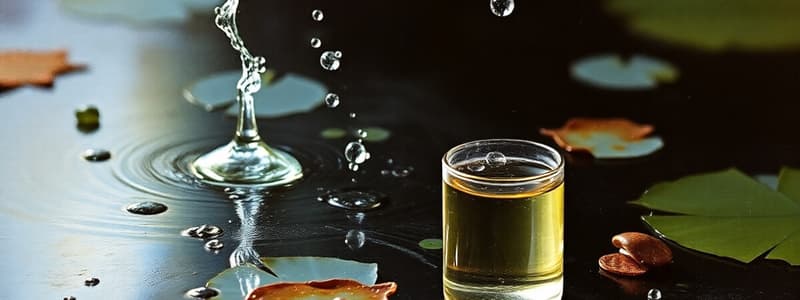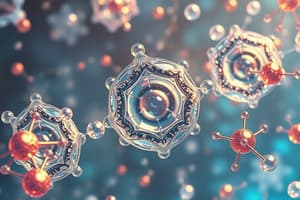Podcast
Questions and Answers
What property of water allows it to dissolve many substances?
What property of water allows it to dissolve many substances?
- Dipolar nature (correct)
- Viscosity
- Density
- High specific heat
Oxygen is less electronegative than hydrogen, which contributes to the dipolar nature of water.
Oxygen is less electronegative than hydrogen, which contributes to the dipolar nature of water.
False (B)
What type of bond occurs between the hydrogen and oxygen atoms within a water molecule?
What type of bond occurs between the hydrogen and oxygen atoms within a water molecule?
Covalent bond
Water is often referred to as the __________ solvent due to its ability to dissolve many types of substances.
Water is often referred to as the __________ solvent due to its ability to dissolve many types of substances.
Match the type of bond to its description:
Match the type of bond to its description:
What role does water play in biological systems?
What role does water play in biological systems?
Water only participates in chemical reactions as a reactant.
Water only participates in chemical reactions as a reactant.
What does water do to charged molecules?
What does water do to charged molecules?
Water plays a significant role in the movement of molecules into and throughout __________ compartments.
Water plays a significant role in the movement of molecules into and throughout __________ compartments.
Which of the following is NOT a function of water in biological systems?
Which of the following is NOT a function of water in biological systems?
Match the terms related to water with their descriptions:
Match the terms related to water with their descriptions:
What is the significance of water's ability to participate in chemical reactions?
What is the significance of water's ability to participate in chemical reactions?
Water has no effect on the solubility of substances.
Water has no effect on the solubility of substances.
What is the primary reason ionic substances dissolve in water?
What is the primary reason ionic substances dissolve in water?
Hydrophobic substances can interact well with water.
Hydrophobic substances can interact well with water.
What term describes a solution where two or more substances are homogeneously mixed?
What term describes a solution where two or more substances are homogeneously mixed?
Polar molecules are said to be __________ because they can interact with water.
Polar molecules are said to be __________ because they can interact with water.
Match the type of solubility with its definition:
Match the type of solubility with its definition:
Which factor does NOT affect solubility?
Which factor does NOT affect solubility?
What is defined as the ability of a substance to dissolve in a solvent?
What is defined as the ability of a substance to dissolve in a solvent?
The time needed for a solute to dissolve is referred to as the __________.
The time needed for a solute to dissolve is referred to as the __________.
What is the definition of weight percent (w/w)?
What is the definition of weight percent (w/w)?
A base is a substance that can release hydrogen ions.
A base is a substance that can release hydrogen ions.
What is the definition of molarity (M)?
What is the definition of molarity (M)?
In a 5% EtOH solution, there are _____ mL of EtOH in 100 mL of solution.
In a 5% EtOH solution, there are _____ mL of EtOH in 100 mL of solution.
Match the following concentrations with their definitions:
Match the following concentrations with their definitions:
Which of the following statements about acids is correct?
Which of the following statements about acids is correct?
An amphoteric substance can _____ and _____ hydrogen ions.
An amphoteric substance can _____ and _____ hydrogen ions.
A 3M solution contains 3 moles of solute in 1L of solution.
A 3M solution contains 3 moles of solute in 1L of solution.
Which of the following is the conjugate base of acetic acid?
Which of the following is the conjugate base of acetic acid?
Strong acids only partially ionize in water.
Strong acids only partially ionize in water.
What is the pH of pure water at 25°C?
What is the pH of pure water at 25°C?
Buffers help minimize changes in _____ when an acid or a base is added.
Buffers help minimize changes in _____ when an acid or a base is added.
Match each acid with its conjugate base:
Match each acid with its conjugate base:
What is the range of blood pH levels in a healthy body?
What is the range of blood pH levels in a healthy body?
PH can be defined as the negative logarithm to the base 10 of the hydroxide ion concentration.
PH can be defined as the negative logarithm to the base 10 of the hydroxide ion concentration.
What is the conjugate base of bicarbonate?
What is the conjugate base of bicarbonate?
Flashcards
Water's role as a solvent
Water's role as a solvent
Water dissolves and transports substances in the body, moves molecules into and out of cells, separates charged molecules, and dissipates heat.
Water as a universal solvent
Water as a universal solvent
Water is a key substance for dissolving and transporting molecules in living organisms.
Water's structure's role
Water's structure's role
Water's polar structure is crucial in its ability to dissolve many biological compounds.
Dipolar nature of water
Dipolar nature of water
Signup and view all the flashcards
Hydrogen bond
Hydrogen bond
Signup and view all the flashcards
Water's function in cells
Water's function in cells
Signup and view all the flashcards
Covalent Bond (Water)
Covalent Bond (Water)
Signup and view all the flashcards
Solubility in water
Solubility in water
Signup and view all the flashcards
Electronegativity (water)
Electronegativity (water)
Signup and view all the flashcards
Water's role in heat dissipation
Water's role in heat dissipation
Signup and view all the flashcards
Calculating solution concentrations
Calculating solution concentrations
Signup and view all the flashcards
Components of acids/bases
Components of acids/bases
Signup and view all the flashcards
Ionic substance solubility
Ionic substance solubility
Signup and view all the flashcards
Hydrophilic molecule
Hydrophilic molecule
Signup and view all the flashcards
Hydrophobic molecule
Hydrophobic molecule
Signup and view all the flashcards
Amphiphilic molecule
Amphiphilic molecule
Signup and view all the flashcards
Solution
Solution
Signup and view all the flashcards
Solubility
Solubility
Signup and view all the flashcards
Factors affecting solubility
Factors affecting solubility
Signup and view all the flashcards
Factors affecting dissolving speed
Factors affecting dissolving speed
Signup and view all the flashcards
Conjugate Base
Conjugate Base
Signup and view all the flashcards
What is a conjugate base?
What is a conjugate base?
Signup and view all the flashcards
Strong Acids
Strong Acids
Signup and view all the flashcards
Weak Acids
Weak Acids
Signup and view all the flashcards
pH
pH
Signup and view all the flashcards
What is pH?
What is pH?
Signup and view all the flashcards
Buffers
Buffers
Signup and view all the flashcards
Blood pH
Blood pH
Signup and view all the flashcards
Weight percent (w/w)
Weight percent (w/w)
Signup and view all the flashcards
Volume percent (v/v)
Volume percent (v/v)
Signup and view all the flashcards
Weight/volume percent (w/v)
Weight/volume percent (w/v)
Signup and view all the flashcards
Molarity (M)
Molarity (M)
Signup and view all the flashcards
What is an acid?
What is an acid?
Signup and view all the flashcards
What is a base?
What is a base?
Signup and view all the flashcards
What is an amphoteric substance?
What is an amphoteric substance?
Signup and view all the flashcards
Acid ionization
Acid ionization
Signup and view all the flashcards
Study Notes
Water, Acids, Bases, and Buffer Systems
- Water structure: Water is a dipolar molecule, meaning it has a slightly positive and slightly negative end due to oxygen's higher electronegativity.
- Water's solubility: Water is a universal solvent due to its polarity. It dissolves many ionic and polar substances.
- Water's role in biological molecules: The properties of water dominate the way biological molecules interact.
- Water in the human body: The human body is mostly water (about 60%) with different percentages for different age groups. Intracellular fluid (ICF) is within cells and extracellular fluid (ECF) is outside of cells (Plasma and Interstitial fluid).
- Water as a universal solvent: Water dissolves and transports compounds in the blood, plays a role in molecule movement, separates charged molecules, dissipates heat, and participates in chemical reactions.
- Solubility: Polar molecules interact with water and dissolve, non-polar molecules do not interact with water and do not dissolve.
- Amphiphilic molecules: Some molecules have both polar and non-polar parts.
- Membrane formation: Amphiphilic molecules form structures like micelles, vesicles, and double membranes, which are important for cell membranes and transport.
- Solutions: Solutions are homogeneous mixtures of two or more substances, with a major component (solvent) and a minor component (solute). Examples of different types of solutions and their classifications were illustrated.
- Factors affecting solubility: The type of solute and solvent, temperature, pressure, and common ion effect affect solubility.
- Factors affecting dissolving speed: Temperature, particle size, and mixing affect dissolving speed.
- Amount of solute in a solution: Different ways to express concentration include weight percent (w/w), volume percent (v/v), weight/volume percent (w/v), molarity (M), and others.
- Acid/Base: Acids release hydrogen ions (H+), while bases accept hydrogen ions. Amphoteric substances can act as both acids and bases.
- Acid/Base examples and Conjugate Bases: Examples of acid-base pairs are presented.
- Buffers: Buffers minimize pH changes when acids or bases are added to a solution, consisting of a weak acid and its conjugate base. These conjugates work together to maintain the pH of a solution.
- Regulation of blood pH: The bicarbonate buffer and phosphate buffer systems are critical in maintaining the pH of blood at a stable level.
Studying That Suits You
Use AI to generate personalized quizzes and flashcards to suit your learning preferences.




